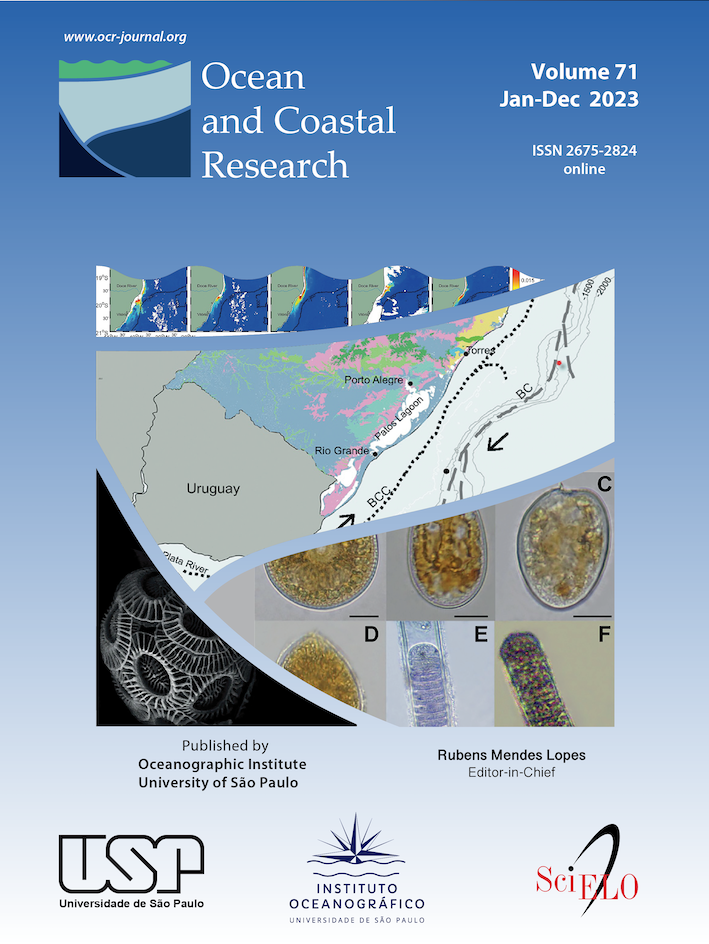Obtaining surface current field from drone imaging
DOI:
https://doi.org/10.1590/Keywords:
Coastal hydrodynamicAbstract
Knowledge of coastal hydrodynamics is essential for understanding the processes of transport of dissolved or particulate material since in these areas there are large ports and the vessel traffic with a greater possibility of accidents. Studies related to currents are of fundamental importance to support decision-making to mitigate environmental impacts. The present work aims to test the technique of measuring currents through drones, as it has the advantage of a quick response in obtaining and analyzing data. For this study, a field survey was carried out in the region of the mouth of Lagoa dos Patos, RS, Brazil. The method's validation was done through the use of a colored tracer in which it was used to measure the surface current velocities simultaneously with the vectors generated by the drone. The results obtained a percentage difference between the methods of 10%, both for speed and for current direction, showing to be very promising for the use of drones to obtain surface current fields. In this way, it opens a new perspective in carrying out field experiments, so new experiments will be carried out to verify the feasibility of using this technique in different conditions, such as in the surf zone and areas with the presence of density fronts.
References
ELTNER, A., SARDEMANN, H. & GRUNDMAN, J. 2020. Flow velocity and discharge measurement in rivers using terrestrial and unmannedaerial-vehicle imagery. Hydrology and Earth System Sciences, 24(3), 1429-1445.
FONG, D. A. & MONISMITH, S. G. 2004. Evaluation of the Accuracy of a ShipMounted, Bottom-Tracking ADCP in a Near-Shore Coastal Flow. Journal of Atmospheric and Oceanic Technology, 21(7), 1121-1128.
HALPERN, B. S., WALBRIDGE, S., SELKOE, K. A., KAPPEL, C. V., MICHELI, F., CASEY, K. S., FOZ, H. E. & HEINEMANN, D. 2008. A global map of human impact on marine ecosystems. Science, 319(5865), 948-952.
LUMPKIN, R. & PAZOS, M. 2007. Measuring surface currents with Surface Velocity Program drifters: the instrument, its data, and some recent results. Lagrangian Analysis and Prediction of Coastal and Ocean Dynamics, 39, 67.
MARONE, E., SCHETTINI, C. A. F., SIEGLE, E., NIENCHESKI, L. F., MADUREIRA, L. A. S. P, WEIGERT, S., PINHO, M. P. & COLETTO, J. L. 2020. Oceanografia operacional. In: LANA, P. C. & CASTELLO, J. (orgs.). Fronteiras do conhecimento em ciências do mar. Rio Grande: FURG, pp. 54-92.
MOOERS, C. N. K., STANLEY, D. J. & SWIFT, D. J. P. 1976. Marine sediment transport and environmental management. In: STEWART, R. H. (ed.). Introduction to the physical oceanography and fluid dynamics of continental margins. New York: Wiley, pp. 7-21.
NOVI, L., RAFFA, F. & SERAFINO, F. 2020. Comparison of measured surface currents from high frequency (HF) and X-band radar in a marine protected coastal area of the Ligurian sea: toward an integrated monitoring system. Remote Sensing, 12(18), 3074.
PERKOVIC, D., LIPPMAN, C. & FRASIER, J. 2009. Longshore surface currents measured by doppler radar and video PIV techniques. IEEE Transactions on Geoscience and Remote Sensing, 47(8), 2787-2800.
POULAIN, P. M., WARN-VARNAS, A. & NIILER, P. P. 1996. Near-surface circulation of the Nordic seas as measured by Lagrangian drifters. Journal of Geophysical Research: Oceans, 101, 18237-18258.
STRELNIKOVA, D., PAULUS, G., KÄFER, S., ANDERS, K., MAYR, P., MADER, H. & SCHNEEBERGER, R. 2020. Drone-based optical measurements of heterogeneous surface velocity fields around fish passages at hydropower dams. Remote Sensing, 12(3), 384.
STRESSER, M., CARRASCO, R. & HORSTMANN, J. 2017. Video-based estimation of surface currents using a low-cost quadcopter. IEEE Geoscience and Remote Sensing Letters, 14(11), 2027-2031.
YUROVSKY, Y., KUBRVAKOV, A., PLOTNIKOV, V. & LISHAEV, N. 2022. Submesoscale currents from UAV: an experiment over small-scale eddies in the coastal black sea. Remote Sensing, 14(14), 3364.


